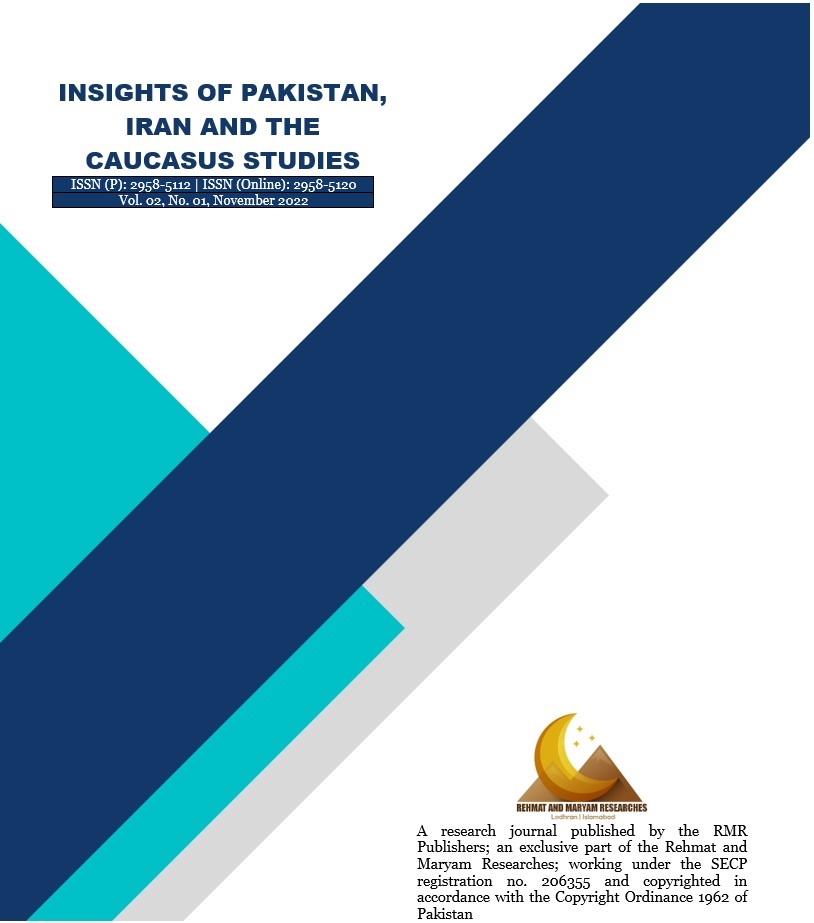Tracing Autonomism, Mutualism and Direct Democracy within the Political Economy of Punjab; A Special Focus on the Demands for New Province(s)
Keywords:
Third Positionism, Authoritarian Liberalism, Tight Federalism, One Unit, Policy Initiatives, Free MarketAbstract
Post-1960 term of “Autonomism” cannot be referred to as a single ideology or movement but it is a series of different socio-political movements that were/are against centralized decisions. On the other hand, “Mutualism” deals with the free market and occupation of resources (and somewhat means of basic necessities). At the same time, the term “Direct Democracy” allows people to decide their policy initiatives directly.
By analyzing political culture, it has been clearly observed that the Punjab Province in Pakistan is experiencing conflicting paradigms between these three ideologies (directly or indirectly). At one side, different sorts of ethnic identities seek regional autonomy; in terms of either forming new provinces, restoring Devolution Plan of Pervez Musharraf, announcing One Unit, or, establishing administrative units/regions within the Punjab Province. Similarly, on another side, different fractions believe in mutualism. Although, they defend the “free market” within the territorial jurisdiction of the country and beyond, for the occupation of resources, they have contradictory viewpoints. Some follow principles of “Third Positionism” while, some look at “Authoritarian Liberalism” at this stage. Along with these two sides, the third side reflects the followers of “Direct Democracy” who demand their role in policy-making and legislation for the areas where they live. This fraction of people not only seeks pure local self-government at district level but also demand new provinces on administrative grounds.
This study highlights why the followers of autonomism, mutualism and direct democracy have contradictions in opinion for staying within the Punjab Province or demanding new province(s) within Punjab. As “Third Positionism” traces political and economic control over the resources on ethnic bases, this study mentions how it is being conflicted with “Authoritarian Liberalism” under the expected restoration of “One Unit” or “Tight Federalism” under the presidential system. In the last, Study analyzes the impacts of respective ideologies and tries to conclude whether they are stimulating movements for the new province(s) or not; if yes then in which shape/style, and, if no then why.
References
Adeney, K. (2012). A Step Towards Inclusive Federalism in Pakistan? The Politics of the 18th Amendment. The Journal of Federalism, 497-750.
Antonio, R. J. (2000). After Postmodernism: Reactionary Tribalism. New York: American Journal of Sociology.
Baofu, P. (2009). The Rise of Authoritarian Liberal Democracy. London: Cabridge Scholars Publications.
Carson, K. A. (2006). Studies in Mutualist Political Economy. New York: CreateSpace Independent Publishing Platform.
Coogan, K. (1999). Dreamer of the Day: Francis Parker Yockey and the Postwar Fascist International. New York: Autonomedia.
Cronin, T. (2013). Direct Democracy. Harvard: Harvard University Press.
Griffin, R. (1995). Fascism. London: Oxford University Press.
Halperin, M. H. (2005). The Democracy Advantage: How Democracies Promote Prosperity and Peace. London and New York: Council on Foreign Relations.
Hashmi, J. (2011, August 03). Hashmi wants Punjab divided into four provinces. Retrieved November 01, 2019, from DAWN: https://www.dawn.com/news/649159
Katsiaficas, G. (2012). Fire and Flames: A History of the German Autonomist Movement. Oakland: PM Press.
Khan, M. H. (2019, January 19). MQM-P demands amendment in constitution for 'empowered local government system'. Retrieved 2019, from DAWN: https://www.dawn.com/news/1458352
Khan, m. S. (2014, June 06). ETHNIC FEDERALISM IN PAKISTAN: FEDERAL DESIGN, CONSTRUCTION OF ETHNO-LINGUISTIC IDENTITY & GROUP CONFLICT. Retrieved 2019, from Ideas PK: https://ideaspak.org/images/Publications/Social-Exclusion-and-Marginalization/Ethnic-Federalism-in-Pakistan.pdf
Maiz, R. (2014). Identity and Territorial Autonomy in Plural Societies. London and New York: Routledge.
Marshall, T. J. (2016). Autonomist Marxism, Critique and the Commons in Post-2008 Social Movements. Aberystwyth: Aberystwyth University.
Miller, F. P. (2010). Mutualism (economic Theory): Cost the Limit of Price, Mutual Credit, Agorism, Cincinnati Time Store, Consumers' Cooperative, Egalitarianism, Individualist Anarchism, Labor Theory of Property, Left- Libertarianism. London and Paris: Alphascript Online Publishing.
PBS. (2017). Percentage Distribution of Households by Language Usually Spoken and Region/Province,1998 Census. Retrieved November 01, 2019, from Pakistan Bureau of Statistics: http://www.pbs.gov.pk/sites/default/files/other/yearbook2011/Population/16-20.pdf
Punjab. (2017). Punjab Population 2017. Retrieved November 01, 2019, from Population of Punjab Census 2017: http://www.pakinformation.com/population/punjab.html
Rasool, A. (2018, May 08). How can a country of 200 million only have four provinces? Retrieved 2019, from DAWN: https://www.dawn.com/news/1406387
Rehman, J. A. (2013, July 13). JI demands restoration of Musharraf’s devolution plan. Retrieved 2019, from The Nation: https://nation.com.pk/30-Jul-2013/ji-demands-restoration-of-musharraf-s-devolution-plan
Sumra, D. K. (2017, December 19). For a democratic Pakistan, more power needs to be given to local governments. Retrieved 2019, from DAWN: https://www.dawn.com/news/1377577
Tahir-ul-Qadri. (2018, December 27). New provinces be made on administrative grounds: Dr Tahir-ul-Qadri. Retrieved 2019, from Minhaj-ul-Quran International: https://www.minhaj.org/english/tid/45663/New-provinces-be-made-on-administrative-grounds-Dr-Tahir-ul-Qadri.html
UNdata. (2019). Total population, both sexes combined (thousands). Retrieved October 29, 2019, from UNdata: http://data.un.org/Data.aspx?d=PopDiv&f=variableID%3a12%3btimeID%3a83%2c84%3bvarID%3a2&c=2,4,6,7&s=_crEngNameOrderBy:asc,_timeEngNameOrderBy:desc,_varEngNameOrderBy:asc&v=1
UNstats. (2019). Population by sex, annual rate of population increase, surface area and density Population selon le sexe, taux d’accroissement annuel de la population, superficie et densité. Retrieved October 20, 2019, from UN Statistics: https://unstats.un.org/unsd/demographic/products/dyb/dyb2012/Table03.pdf
Downloads
Published
Issue
Section
Categories
License
Copyright (c) 2022 Insights of Pakistan, Iran and the Caucasus Studies

This work is licensed under a Creative Commons Attribution-NonCommercial-NoDerivatives 4.0 International License.

